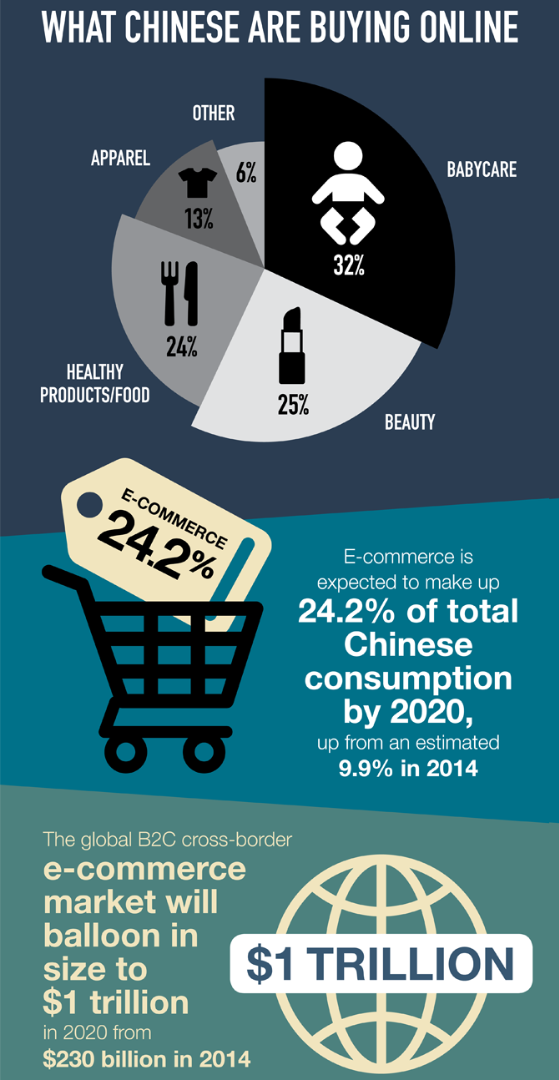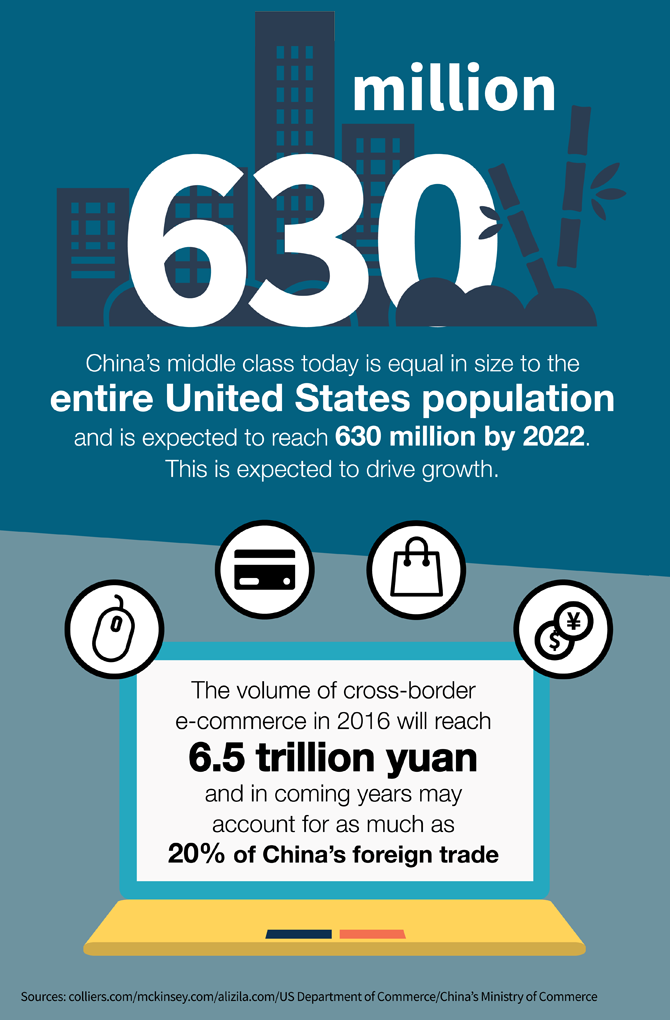-
China’s consumer economy is booming. So too, despite the well-publicised restrictions on content and channels, is the online economy. Now add ‘foreign goods’ to the fuel because cross border e-commerce is a boom within a boom – to the extent the government has just introduced some new controls on commerce.
" Rampant consumer demand for foreign products is one thing but there are other, lower-profile factors at play."
Casey Hall, Freelance journalistRampant consumer demand for foreign products is one thing but there are other, lower-profile factors at play, one of which is the expansion of free-trade zones (FTZs) in China.
The first trial zone opened in Shanghai in 2014, followed by four others in significant coastal cities in 2015. Many more local governments are clamouring to be next in line for their own version in 2016 and beyond.
The opening of FTZs has cut much of the red tape associated with importing products from other countries over a range of product segments, making it possible, for example, for Chinese consumers to order fresh food from Australia or South America, and have it delivered to their door 72 hours later (if they live in a first-tier city such as Shanghai).
At the same time as FTZs have begun opening up around China, the country’s consumers have developed a serious affinity for products from overseas.
MAIN DESIRE
According to Patrice Nordey, the Shanghai-based chief executive officer of digital inception agency Velvet, the main desire is for brands Chinese consumers have discovered while traveling internationally or for products that are perceived to be of better quality when sourced overseas.
One-hundred-and-twenty million Chinese travellers headed overseas in 2015, up almost 20 per cent on 2014, according to the China National Tourism Association.
“A lot of people are using cross border to buy products that are not available or considered safe in China – baby milk powder, health products, and food products,” Nordey said. “Consumers are eager to buy these products because they don’t feel they can access them safely in China.”
The average shopper in Australia or New Zealand has seen the impact of this demand, with ‘dai gou’ or unofficial parallel importers emptying shelves in these countries of products such as milk powder, vitamins and some cosmetic products, to resell on China’s largest consumer-to-consumer (C2C) platform, Alibaba’s Taobao.
{CF_IMAGE}
In 2015, when major business-to-consumer (B2C) platforms such as Alibaba’s Tmall platform and China’s largest direct-to-consumer e-retailer JD.com decided to get in on the act, products overseas went from a purely grey market, to a legitimate force.
“Alibaba, JD and Amazon are all staking their futures on cross border e-commerce,” Tompkins International Consulting principal Michael Zakkour said.
“You can see it in the way Alibaba has been growing [Alibaba’s cross-border platform] Tmall Global] and Amazon is buying assets so that they own 100 per cent of the shipping and delivery of goods.”
“Both companies have a stated goal of winning two billion new cross-border customers and the ability to deliver to and from anywhere on earth in two to three days, affordably.”
According to Haoyu Shen, Chief Executive Officer of the Nasdaq-listed JD Mall, the company’s cross-border platform grew “triple digits” off an admittedly low base (estimated by industry experts to be around 1 per cent of the company’s total business, though JD.com declined to confirm this figure) in 2015.
“[Cross border] will continue to be a focus for us this year, and it’s an area where we are seeing tremendous growth,” he said.
{CF_IMAGE}
RED
The boom has also brought new social network-based e-commerce sites into the mix, such as Xiao Hong Shu (the company’s Chinese name translates to ‘Little Red Book’, but it’s known in English simply as RED).
RED grew out of a bulletin board service for women (between 80 per cent and 90 per cent of its 18 million registered users are female) to let others know about the great brands and products they came across while shopping overseas.
According to Elaine Lou, VP of e-commerce for RED, women on their platform went from talking about products they had bought overseas to wanting a platform where they could actually buy these brands within China
“The products in our community are mainly not in China yet, so it had to be done using cross border e-commerce,” Lou said.
“At the end of 2014 the Free-Trade Zone boomed up and that opened up opportunities from cross-border commerce and they were welcoming to companies like us coming in there. I have to say we were very lucky, the timing was perfect.”
Lucky or not, the young enterprise has been rather successful to date, having just raised over $US10 million in its series B round of funding and racking up sales revenue of 700 million yuan ($A140 million) in the six months to September 2015.
{CF_IMAGE}
PAYING ATTENTION
The Chinese government has also been paying attention to increasing cross border e-commerce, not least as a way to boost sluggish foreign trade. In 2015, total export and import value decreased 7 per cent year-on-year, the first time China’s foreign trade has fallen since 2009.
According to China’s Ministry of Commerce, the volume of cross-border e-commerce in 2016 will reach 6.5 trillion yuan and in coming years may account for as much as 20 per cent of China’s foreign trade.
So it came as a surprise to many industry insiders when, last month, the government announced a change in the way in which e-commerce packages would be taxed when entering China.
For many product categories the change increased the amount of tax that would need to be paid (previously, the vast majority of personal packages coming into the country were simply levied a flat 10 per cent).
Under the new system, which came into effect on April 8, these packages are essentially treated more like commercially imported products, subject to import, customs and VAT charges of varying rates in China, depending on the product category.
According to Zakkour, although extra importation charges may seem to be an attempt to hobble the burgeoning industry and encourage Chinese consumers to shop at home (as some commentators have claimed) the change is simply an attempt to close loopholes for C2C dai gou agents and legitimise the industry for B2C players.
“The changes will have a minimal net impact on cross -border sales,” Zakkour said. “Many product categories, such as cosmetics and body care, will benefit, others will see an increase in taxes, such as certain food and beverage products, but overall it is not going to dampen growth.”
“The desire for foreign products in China is continuing to grow. Chinese consumers are willing to pay a premium for foreign products for reasons of trust, authenticity and safety.”
“What will amount to something like an 11 per cent tax on these products will not dampen this desire, especially as these products will still be more affordable than buying in brick-and-mortar stores in China.”
Casey Hall is a freelance journalist who has worked in Shanghai for more than six years including stints as Managing Editor for Talk Magazines and as a contributor to a variety of international publications, including The Wall Street Journal Asia, International New York Times, CNN International and Forbes.
The views and opinions expressed in this communication are those of the author and may not necessarily state or reflect those of ANZ.
-
-
-
EDITOR'S PICKS
-
ANZ chief executive Shayne Elliott is in Beijing for the Australia-China CEO Roundtable and Australia Week in China. He believes reform of the financial system is essential for China’s continued development and this is an edited transcript of a speech he gave on the subject.
15 April 2016 -
One of my weekly chores growing up in Minnesota was ironing my father's business shirts. He was a stylish man and his pinpoint oxford shirts were one-hundred per cent cotton with a fine finish.
1 April 2016 -
China’s transition toward a consumption-led economy is clearly underway.
20 April 2016



